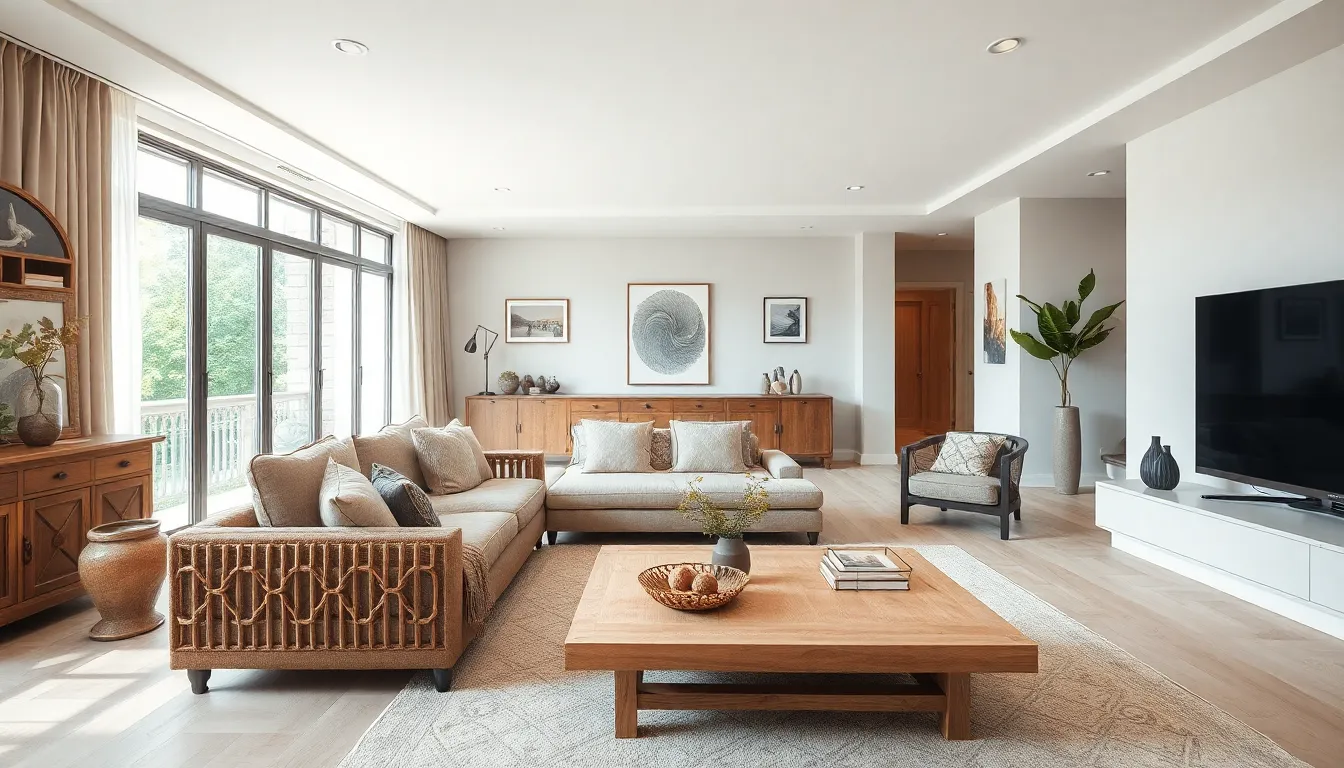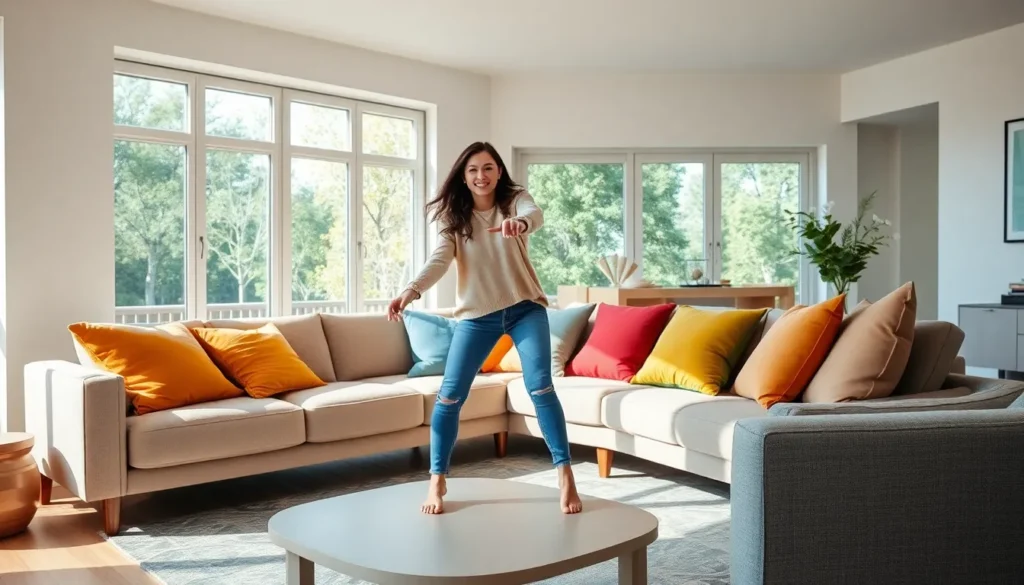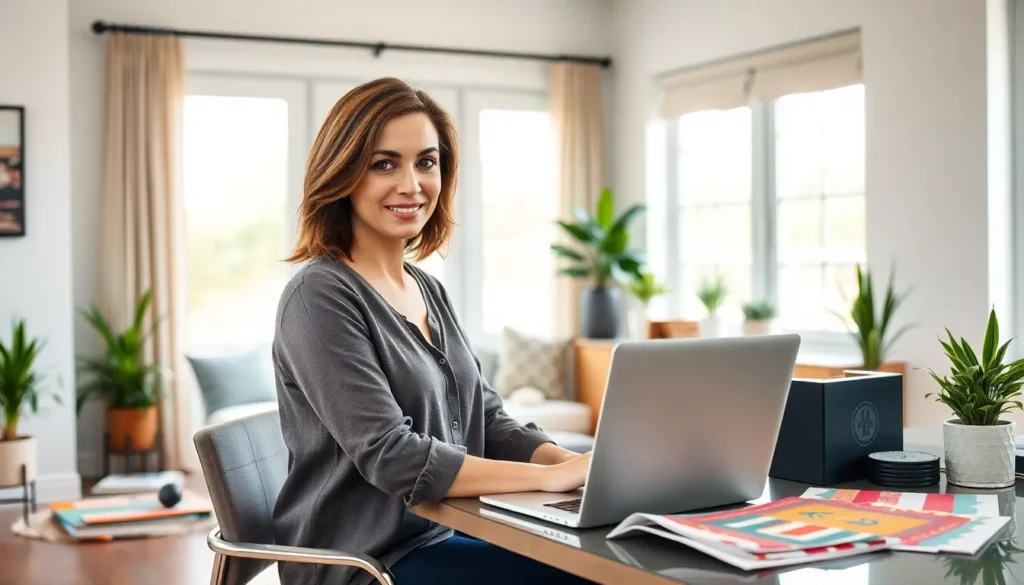Home is where the heart is, but let’s be honest—it’s also where the questionable design choices lurk. From that neon green accent wall that seemed like a good idea at 2 AM to the collection of garden gnomes that has taken over the living room, interior design can sometimes feel like a game of “how not to embarrass yourself in front of guests.”
Table of Contents
ToggleUnderstanding Home Interior Design
Home interior design encompasses the art and science of enhancing a space’s interior to create a healthier and more aesthetically pleasing environment. It invites a blend of creativity and functionality, emphasizing personalized touches that reflect individual lifestyles.
Key Elements of Interior Design
Designers prioritize several key elements. Color plays a vital role, influencing emotions and mood. Space planning allows for optimal layout, ensuring efficient use of each area. Light selection impacts visibility while highlighting features. Texture adds depth and interest, contributing to visual appeal. Furniture selection shapes both functionality and style. Accessories, like artwork and decor, finish spaces, adding personality.
Importance of Functionality and Aesthetics
Balancing functionality with aesthetics is crucial. Spaces should serve their intended purpose while looking visually attractive. Practicality meets elegance when furniture is both comfortable and stylish. Well-designed areas enhance everyday activities, making tasks enjoyable. An aesthetically pleasing atmosphere fosters relaxation and well-being. Designers aim to create a cohesive look that marries beauty with usability, ensuring spaces not only look good but also work effectively.
Popular Home Interior Design Styles

Home interior design features diverse styles, each with unique characteristics and appeals. Understanding these styles helps in creating spaces that reflect personal taste.
Modern Design
Modern design emphasizes clean lines and simplicity. It often showcases open spaces with minimalistic furniture and neutral color palettes. Natural light plays a crucial role in modern interiors, enhancing the overall ambiance. Elements like geometric shapes and a blend of materials, such as metal and wood, further define this style. Accessories remain minimal to avoid clutter, allowing for a serene environment that promotes relaxation.
Traditional Design
Traditional design embodies classic elegance and comfort. This style typically incorporates rich colors, ornate furniture, and intricate details. Patterns in textiles, such as floral or paisley, add warmth and depth. Dark wood tones are common, showcasing craftsmanship. Family heirlooms often find a place in traditional spaces, creating a sense of history and personal connection. Textiles like silk and velvet enhance the luxurious feel, making the home inviting and sophisticated.
Scandinavian Design
Scandinavian design focuses on functionality and simplicity, often highlighting a connection to nature. Light, airy spaces dominate this style, featuring whites and soft pastels. Natural materials, such as wood and leather, are frequently used to create a warm, inviting atmosphere. Clean lines and minimal ornamentation invite tranquility and peace. This design also emphasizes sustainability, promoting eco-friendly practices through the use of recycled materials.
Tips for Effective Home Interior Design
Effective home interior design enhances comfort and aesthetics while improving daily functionality.
Color Schemes and Palettes
Selecting harmonious color schemes establishes a mood in any space. Start with a focal color, then choose complementary shades that support it. Neutral tones provide a timeless backdrop while allowing vibrant accents to shine. For instance, a light gray base invites striking art pieces to stand out. Incorporating three to five colors can maintain balance without overwhelming decor. Testing samples on walls can help visualize how different shades interact with light. This careful consideration shapes an inviting environment tailored to personal style.
Furniture Arrangement
Arranging furniture enhances flow and usability throughout living areas. Prioritize the function of each room when positioning furniture pieces. Create a conversation area with sofas and chairs angled towards each other, promoting interaction. Ensure pathways remain clear to facilitate movement, allowing for comfortable navigation. Grouping items by height and style adds visual interest and cohesion. Using rugs can define spaces within larger rooms, making them feel cozy. People can strategically place larger furniture away from walls to encourage a more intimate feel.
Lighting Techniques
Lighting significantly impacts mood and functionality in interior spaces. A combination of ambient, task, and accent lighting ensures versatility. Overhead fixtures provide general illumination, while table lamps serve specific activities. Dimmers allow users to adjust brightness, creating a relaxed atmosphere as needed. Natural light should be maximized through window treatments that invite sunlight while offering privacy. Using a mix of light sources and intensities enhances depth and visual appeal. Experimenting with different lighting options complements design elements, transforming the overall ambiance.
Incorporating Personal Touches
Incorporating personal touches elevates home interior design, making spaces feel uniquely yours.
Art and Decor Options
Selecting art plays a critical role in personalizing spaces. Original paintings or prints reflect individual tastes and can significantly influence the ambiance. Family photos displayed as gallery walls create warmth while showcasing memories. Incorporating handmade decor items adds character, making each piece a conversation starter. Choosing items that resonate emotionally enhances the overall design. Accessories like vases, sculptures, or wall hangings further contribute personality to rooms, ensuring they align with individual style preferences.
DIY Projects for Customization
Engaging in DIY projects offers endless customization possibilities. Painting furniture enables a fresh look that resonates with personal aesthetic. Creating custom shelves or decor items infuses creativity into design while addressing specific needs. Handmade cushions or throw blankets not only enhance comfort but also offer opportunities to showcase favorite fabrics or patterns. These projects create a sense of achievement while transforming a house into a home. Tailoring design elements through DIY not only beautifies spaces but also embeds personal stories into the decor.
Creating a home that balances comfort and style is a rewarding journey. By embracing personal tastes and integrating key design principles, anyone can transform their space into a sanctuary. The right color schemes furniture arrangements and lighting choices can significantly enhance both the aesthetic appeal and functionality of a home.
Incorporating unique decor and personal touches not only reflects individuality but also fosters a sense of belonging. With thoughtful planning and creativity anyone can turn their living environment into a true reflection of who they are. Ultimately a well-designed home serves as a backdrop for cherished memories and everyday moments, enriching life in countless ways.





